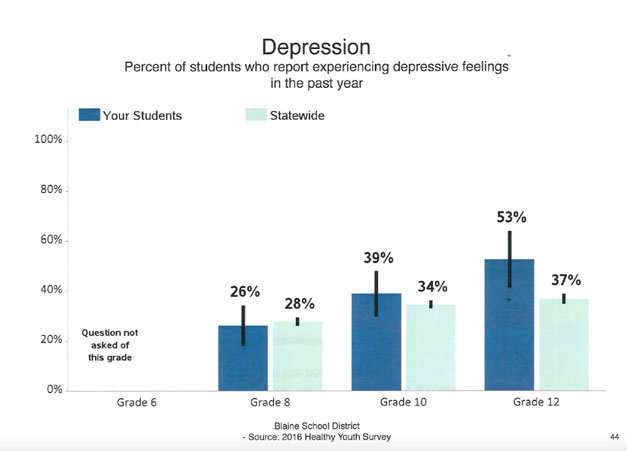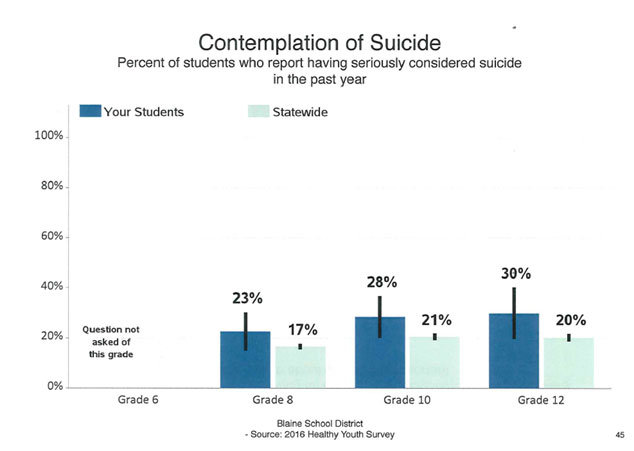 By Oliver Lazenby
By Oliver Lazenby In a 2016 survey, between 8.6 and 13.6 percent of Blaine students in grades 8, 10 and 12 reported they’d tried to kill themselves in the past year. Even more had considered suicide or made a plan to kill themselves.
Statistics on youth suicide and depression have grown grimmer throughout the state in the last 10 years, but the 2016 Healthy Youth Survey results reveal that problems may be especially severe in the Blaine school district.
The Healthy Youth Survey is an anonymous survey given throughout Washington state to students in sixth, eighth, 10th and 12th grades every other year. Containing 252 questions, it covers a variety of behavioral topics including alcohol and drug use, family life, nutrition and mental health. Blaine students reported feeling anxious, depressed and considering suicide at rates higher than the county and state averages.
In the survey, 26 percent of Blaine 10th graders and 30 percent of 12th graders reported considering suicide in the past year. Twenty percent of 12th graders in the state reported considering suicide –10 percentage points fewer than in Blaine.
Are the results accurate?
The guidelines accompanying the Healthy Youth Survey’s results state that if less than 70 percent of a grade takes the survey, the results “may be representative of students in this grade,” whereas if more than 70 percent take it, results are “probably representative of students in this grade.” Below 40 percent, the results “are likely not representative.”
Some of the survey’s most troubling statistics come from Blaine’s 12th grade class, but just 43 percent of the class – 80 students – actually took the survey and only 40 students answered the questioning about attempting suicide in the past year.

Why Blaine?
Why might the problem be worse in Blaine? Joe Fuller, program specialist for the Whatcom County Health and Human Services Department works with county Healthy Youth Survey data, but doesn’t analyze district-specific data, he said.
In general, Fuller said substance abuse, bullying and a variety of other factors can affect rates of depression, but feeling isolated is probably the most important factor.
“If young people don’t feel like they have a healthy connection to individuals in the community, that can be really detrimental,” he said.
Randy Elsbree, school district director of federal and special programs, said poverty could be a factor in district data. Nearly 50 percent of local students qualify for free or reduced lunch.
“We have higher poverty and that’s a pressure,” Elsbree said. “If you don’t know where you’ll be able to get your next meal from, that’s a source of anxiety.”
Countywide, Blaine is in the middle of the pack in percentage of students who qualify for free and reduced lunch: as of 2014, Ferndale, Nooksack Valley and Mount Baker school districts all had a higher percentage of students who qualify for free and reduced lunch, according to the National Center for Education Statistics.
Releasing the results
Though the school district has had results from the Healthy Youth Survey since May, results were not made public or presented to the school board. The results were posted at a December 15 meeting of the Blaine Birch Bay Healthy Youth Coalition after members of that group – which aims to alleviate youth mental health problems – obtained the results from the district.
The Northern Light received the survey results after requesting them from the district.
This is the first time since the district began participating in the Healthy Youth Survey in 2002 that the results have been made available to the general public. Survey guidelines don’t make a recommendation on releasing results and most Whatcom County school districts don’t make their data public.
Elsbree said parts of the data have been presented to the school board in past years.
“I don’t know if the school board really wanted the full-scale presentation,” Elsbree said. “I think they want to know what it is and are we addressing the needs that are reflective in Blaine data.”
Erika Creydt, clinical director at TouchStone Health Clinic, a mental and physical health clinic in Blaine, said the data is helpful for addressing the various issues it details. In future surveys, she hopes the district will include the questions that involve sexual health, sexual abuse and sexual orientation because those questions “provide critical information about child and adolescent mental health in our community,” she said. The district opted out of those questions in the last survey.
The district didn’t ask those questions because it feared doing so would cause more students and their parents to opt out of the survey, said Jessie Burton, family coordinator and homeless liaison at the district’s Family Service Center, and prevention and intervention specialist.
What’s the school district doing?
Although the district didn’t publicize the survey, it did work to address it, Elbsree said.
“We’re not hiding the data – we’re certainly working with the data and developing programs based on it,” he said.
In August, the district hired a mental health counselor, Kaatri Jones, who works with at-risk students in all district schools. Currently about 50 students see Jones or one of the district’s contracted mental health counselors weekly or bi-weekly, Elsbree said.
Jones’ salary is partly funded by the Whatcom County Health Department, which also funds an intervention and prevention specialist and staff training in understanding mental health challenges for students, among other things.
The county health department and the Whatcom Prevention Coalition have partnered with all county school districts on a youth suicide prevention workshop called MAD-HOPE (Making a Difference – Helping Other People Everywhere) that trains people to look for suicide warning signs and build connections. Warning signs of suicide include talking about committing suicide, talking about feeling hopeless or being a burden to others, and increasing drug and alcohol use.
This year, high school staff put up a board with the name of every enrolled student, and staff members put dots next to students they’re personally connected with, Burton said.
“The students who didn’t have dots – the staff made a plan to connect with them and check in with them,” Burton said.
The district also hopes to have a crisis line/anonymous tip line up and running in the next month. The high school has set aside time on Fridays for students to meet in teacher-led clubs, and the number of students in clubs has more than doubled this year.
Burton thinks the district has already made progress with these initiatives since the Healthy Youth Survey.
“Kids feel like they have somebody to go to. I think that is the biggest thing. We hear it from friends or other staff members or the kids themselves,” Burton said. “Students have also been a lot more open about coming to staff members and saying they’re worried about a friend.”
Community action
After seeing data from the Healthy Youth Survey, Erika and Jesse Creydt and others formed the Blaine Birch Bay Healthy Youth Coalition, a group that aims to alleviate youth mental health problems in the community in a way the school district doesn’t. The coalition is modeling itself after similar local efforts including the Ferndale Community Coalition and the Whatcom Prevention Coalition.
“The goal of the coalition is to make sure that healthy activities and outlets are more accessible to the kids than drugs and alcohol,” Erika Creydt said.
Kids may have access to counseling in Blaine, but they need more than that, she said.
“Having counseling services available is essential,” she said. “However, having healthy activities for kids to engage in outside of counseling is very important as well.”
Creydt recommends activities such as sports, music and socializing.
The Blaine Birch Bay Healthy Youth Coalition had its second meeting at the Pizza Factory on December 15. The meeting included talks from representatives of the Whatcom County YMCA and the Boy Scouts of America, who spoke about how their organizations make kids feel less isolated, and how those organizations could get more involved in the northwest part of Whatcom County.
The coalition is still fine-tuning its mission, but Erika Creydt hopes that letting people know there’s a problem will bring solutions forward.
“We need to be more mindful about this stuff in our community because there are fewer resources,” Erika said. “We’re going to need thousands of small interventions adding up to where you see differences in the numbers. It’s doable, but it’s going to take all of us.”
The Blaine Birch Bay Healthy Youth Coalition’s next meeting, at 5 p.m. on Monday, January 15 at the Pizza Factory, is a youth brainstorming session, she said. The meeting is open to the public.
Comments
No comments on this item Please log in to comment by clicking here